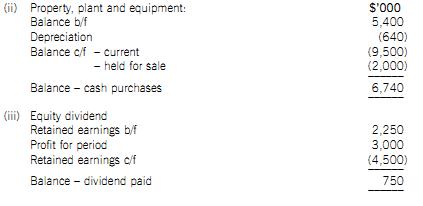小编特收集了ACCA考试历年真题,希望对您参加本次考试有所帮助!
ACCA考试F7考试真题答案6" border="0" alt="" src="//img.wangxiao.cn/files/2011/12/15/6月ACCA考试F7考试真题答案6.jpg" />

(b) Note: references to 2011 and 2010 refer to the periods ending 31 March 2011 and 2010 respectively.
It is understandable that the shareholder’s observations would cause concern. A large increase in sales revenue has not led to a proportionate increase in profit. To assess why this has happened requires consideration of several factors that could potentially explain the results. Perhaps the most obvious would be that the company has increased its sales by discounting prices (cutting profit margins). Interpreting the ratios in the appendix rules out this possible explanation as the gross profit margin has in fact increased in 2011 (up from 40% to 42%). Another potential cause of the disappointing profit could be overheads (distribution costs and administrative expenses) getting out of control, perhaps due to higher advertising costs or more generous incentives to sales staff. Again, when these expenses are expressed as a percentage of sales, this does not explain the disparity in profit as the ratio has remained at approximately 19%. What is evident is that there has been a very large increase in finance costs which is illustrated by the interest cover deteriorating from 36 times to only 9 times. The other‘culprit’ is the taxation expense: expressed as a percentage of pre-tax accounting profit, the effective rate of tax has gone from 28·6% in 2010 to 42·9% in 2011. There are a number of factors that can affect a period’s effective tax rate (including under-or over-provisions from the previous year), but judging from the figures involved, it would seem likely that either there was a material adjustment from an under-provision of tax in 2010 or there has been a considerable increase in the rate levied by the taxation authority.
As an illustration of the effect, if the same effective tax rate in 2010 had applied in 2011, the after-tax profit would have been $3,749,000 (5,250 x (100% – 28·6%) rounded) and, using this figure, the percentage increase in profit would be 50% ((3,749 – 2,500)/2,500 x 100) which is slightly higher than the percentage increase in revenue. Thus an increase in the tax rate and increases in finance costs due to much higher borrowings more than account for the disappointing profit commented upon by the concerned shareholder.
The other significant observation in comparing 2011 with 2010 is that the company has almost certainty acquired another business. The increased expenditure on property, plant and equipment of $6,740,000 and the newly acquired intangibles (probably goodwill) of $6·2 million are not likely to be attributable to organic or internal growth. Indeed the decrease in the bank balance of $4·2 million and the issue of $7 million loan notes closely match the increase in non-current assets. This implies that the acquisition has been financed by cash resources (which the company looks to have been building up) and issuing debt (no equity was issued). This in turn explains the dramatic increase in the gearing ratio (and the consequent fall in interest cover) and the fall in the current ratio (due to the use of cash resources for the business purchase). Although the current ratio at 1·5:1 is on the low side of acceptability, it does include $2 million of non-current assets held for sale. A better comparison with 2010 is the current ratio at 1·2:1 which excludes the non-current assets held for sale. It may be that these assets were part of the acquisition of the new business and are ‘surplus to requirements’, hence they have been made available for sale. They are likely to be valued at their ‘fair value less cost to sell’ and the prospect of their sale should be highly probable (normally within one year). That said, if the assets are not sold in the near future, it would call into question the acceptability of the company’s current ratio which may cause short-term liquidity problems.
The overall performance of Bengal has deteriorated (as measured by its ROCE) from 38·9% to 31·9%. This is mainly due to a lower rate of net asset turnover (down from 1·9 to 1·4 times), however when the turnover of property, plant and equipment is considered (down from 3·2 to 2·7 times) the asset utilisation position is not as bad as it first looks, in effect it is the presence of the acquired intangibles that is mostly responsible for the fall.
Further, it may be that the new business was acquired part way through the year and thus the returns from this element may be greater next year when a full period’s profits will be reported. It may also be that the integration of the new business requires time (and expense) before it delivers its full potential. In summary, although reported performance has deteriorated, it may be that future results will benefit from the current year’s investment and show considerable improvement. Perhaps some equity should have been issued to lower the company’s gearing (and finance costs) and if the dividend of $750,000 had been suspended for a year there would be a better liquid position.

相关文章:
(责任编辑:中大编辑)